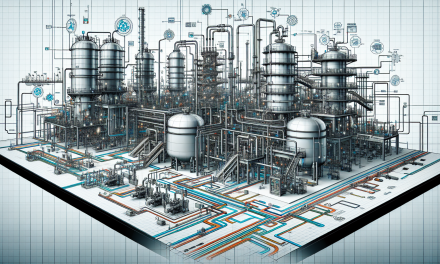Table of Contents
- 1. Introduction
- 2. Understanding Heat Transfer
- 3. Importance of Heat Transfer Augmentation
- 4. Heat Transfer Augmentation Techniques
- 4.1 Surface Augmentation
- 4.2 Externally Enhanced Techniques
- 4.3 Nanofluids in Heat Transfer
- 4.4 Active and Passive Techniques
- 5. Challenges in Implementing Augmentation Techniques
- 6. The Future of Heat Transfer Augmentation
- 7. FAQs
- 8. Conclusion
1. Introduction
In the process industry, heat transfer plays a pivotal role in ensuring systems operate efficiently. Notably, the need for enhanced thermal performance drives growing interest in various heat transfer augmentation techniques. In this blog post, we’ll delve into these techniques, explore their importance, and discuss how innovations are revolutionizing the landscape of thermal management.
2. Understanding Heat Transfer
Heat transfer involves the movement of thermal energy from one substance or material to another. This fundamental process occurs through three primary mechanisms: conduction, convection, and radiation. Understanding these mechanisms helps in selecting and optimizing the appropriate heat exchange methods for various applications.
2.1 Conduction
Conduction occurs when heat energy transfers through a solid material, primarily due to temperature gradients. For example, heating one end of a metal rod results in the opposite end becoming hot over time.
2.2 Convection
Convection involves the transfer of heat through fluids (liquids and gases) as they move. This movement can be natural, driven by buoyancy, or forced, caused by external means like pumps or fans.
2.3 Radiation
Radiation is the transfer of heat through electromagnetic waves and does not require a medium. The sun heating the Earth is a prime example of radiant heat transfer.
3. Importance of Heat Transfer Augmentation
As industries push for higher efficiency, safer operations, and reduced environmental impact, heat transfer augmentation becomes vital. These techniques enhance the heat exchange process, leading to better energy utilization, reduced equipment size, and increased reliability.
3.1 Enhanced Efficiency
By augmenting heat transfer, industries can achieve better thermal performance, thus improving overall process efficiency.
3.2 Economic Benefits
Improved efficiency often results in lower operational costs, making heat transfer augmentation an economically wise choice.
3.3 Environmental Impact
Augmented heat transfer techniques contribute to energy conservation, which aligns with sustainability goals and reduces the environmental footprint of industrial processes.
4. Heat Transfer Augmentation Techniques
Numerous techniques exist for augmenting heat transfer, each offering unique advantages depending on the application. Below, we explore some popular methods.
4.1 Surface Augmentation
Surface augmentation involves altering the heat exchanger surfaces to enhance heat exchange. Techniques include:
- Fins and Extended Surfaces: Adding fins increases the surface area available for heat transfer.
- Textured Surfaces: Employing specific textures enhances turbulence in the fluid, improving heat transfer coefficients.
4.2 Externally Enhanced Techniques
These methods include the use of external devices or flow modifications to promote better heat transfer. Examples include:
- Flow Disruptors: Devices that create turbulence can increase mixing and heat transfer rates.
- Boosted Airflow: Employing fans or blowers can improve heat exchange in various applications.
4.3 Nanofluids in Heat Transfer
Nanofluids are engineered fluids that contain nanometer-sized particles. These fluids exhibit significantly enhanced thermal properties, leading to improved heat transfer performance. The introduction of nanofluids represents a significant advancement in enhancing heat transfer techniques.
4.4 Active and Passive Techniques
These techniques fall into two categories:
- Active Techniques: Require external energy, including mechanical devices to improve heat transfer.
- Passive Techniques: Use natural phenomena to enhance heat transfer without additional energy consumption, like utilizing gravity or natural convection.
5. Challenges in Implementing Augmentation Techniques
While heat transfer augmentation offers several benefits, implementing these techniques comes with challenges. These may include:
- Cost Implications: Initial investments can be high, depending on the chosen technique.
- Complexity of Systems: Integrating new technologies into existing systems may pose engineering challenges.
- Maintenance and Reliability: Some augmentation techniques might require increased maintenance efforts.
6. The Future of Heat Transfer Augmentation
The future of heat transfer augmentation looks promising with ongoing research focused on developing more efficient, cost-effective, and environmentally friendly techniques. Innovations like:
- Smart Materials: These materials can adapt based on environmental conditions, allowing for dynamic heat exchange.
- Advanced Computational Fluid Dynamics (CFD): Enhanced modeling techniques help optimize designs before implementation.
Furthermore, exploring training opportunities in advanced techniques, like those offered in the Advanced Heat Transfer Enhancement Techniques Course, proves invaluable for professionals in the field.
7. FAQs
7.1 What is heat transfer augmentation?
Heat transfer augmentation refers to methods employed to enhance the efficiency of heat exchangers and other thermal systems, improving heat transfer rates between fluids.
7.2 Why is heat transfer augmentation necessary in the process industry?
Augmentation is necessary to increase efficiency, reduce costs, and promote sustainable operations while meeting rigorous industry standards.
7.3 What are some common methods of heat transfer augmentation?
Common methods include surface augmentation with fins, externally enhanced techniques with disruptors, and the use of nanofluids.
7.4 How do nanofluids contribute to heat transfer?
Nanofluids contain nanoparticles that significantly improve thermal conductivity and heat transfer characteristics compared to traditional fluids.
8. Conclusion
Heat transfer augmentation is crucial in optimizing processes across the industry. With various techniques available, each with its benefits and applications, professionals must stay updated on the latest advancements and methodologies. These enhancements lead not only to better efficiency and lower costs but also to reduced environmental impacts overall. As industries continue to evolve, embracing innovative approaches such as nanofluids or advanced surface modifications will empower businesses to thrive. For further insights into related strategies, consider exploring the following resources:
- Mastering Rotating Equipment Optimization Strategies for Continuous Reliability Improvement
- Mastering Process Plant Optimization and Energy Conservation Strategies for Operational Excellence
- A Comprehensive Guide to the ASME Boiler Pressure Vessel Code and B31 Pressure Piping Codes
- Your Ultimate Guide to Developing and Implementing an Energy Management System BS EN 16001 ISO 50001
- Mastering Heat Exchangers: Comprehensive Insights into Types, Applications, Design, Operation, and Maintenance
Staying informed about these evolving trends not only enhances professional knowledge but also significantly benefits the industry’s operational excellence.





